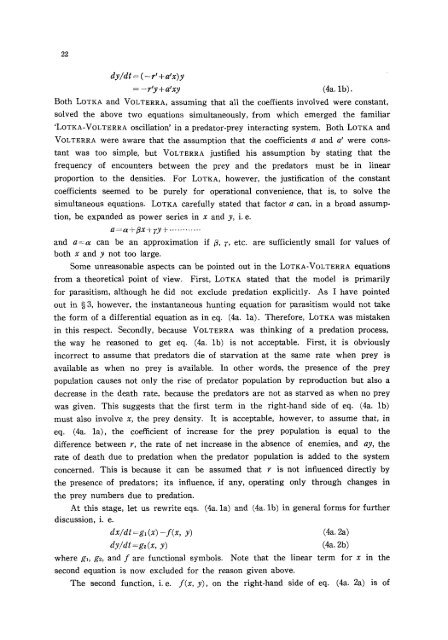A comparative study of models for predation and parasitism
A comparative study of models for predation and parasitism
A comparative study of models for predation and parasitism
Create successful ePaper yourself
Turn your PDF publications into a flip-book with our unique Google optimized e-Paper software.
22<br />
dy/dt: (-r' +a'x)y<br />
= -r'y+a'xy (4a. lb).<br />
Both LOTKA <strong>and</strong> VOLTERRA, assuming that all the coeffients involved were constant,<br />
solved the above two equations simultaneously, from which emerged the familiar<br />
'LOTKA-VoLTERRA oscillation' in a predator-prey interacting system. Both LOTKA <strong>and</strong><br />
VOLTERRA were aware that the assumption that the coefficients a <strong>and</strong> a' were cons-<br />
tant was too simple, but VOLTERRA justified his assumption by stating that the<br />
frequency <strong>of</strong> encounters between the prey <strong>and</strong> the predators<br />
proportion to the densities.<br />
must be in linear<br />
For LOTKA, however, the justification <strong>of</strong> the constant<br />
coefficients seemed to be purely <strong>for</strong> operational convenience, that is, to solve the<br />
simultaneous equations. LOTKA carefully stated that factor a can, in a broad assump-<br />
tion, be exp<strong>and</strong>ed as power series in x <strong>and</strong> y, i.e.<br />
a:oz+~x +ry + ............<br />
<strong>and</strong> a=oz can be an approximation if ~, r, etc. are sufficiently small <strong>for</strong> values <strong>of</strong><br />
both x <strong>and</strong> y not too large.<br />
Some unreasonable aspects can be pointed out in the LOTKA-VoLTERRA equations<br />
from a theoretical point <strong>of</strong> view.<br />
First, LOTKA stated that the model is primarily<br />
<strong>for</strong> <strong>parasitism</strong>, although he did not exclude <strong>predation</strong> explicitly. As I have pointed<br />
out in w 3, however, the instantaneous hunting equation <strong>for</strong> <strong>parasitism</strong> would not take<br />
the <strong>for</strong>m <strong>of</strong> a differential equation as in eq. (4a. la). There<strong>for</strong>e, LOTKA was mistaken<br />
in this respect. Secondly, because VOLTERRA was thinking <strong>of</strong> a <strong>predation</strong> process,<br />
the way he reasoned to get eq. (4a. lb) is not acceptable. First, it is obviously<br />
incorrect to assume that predators die <strong>of</strong> starvation at the same rate when prey is<br />
available as when no prey is available. In other words, the presence <strong>of</strong> the prey<br />
population causes not only the rise <strong>of</strong> predator population by reproduction but also a<br />
decrease in the death rate, because the predators are not as starved as when no prey<br />
was given. This suggests that the first term in the right-h<strong>and</strong> side <strong>of</strong> eq. (4a. lb)<br />
must also involve x, the prey density. It is acceptable, however, to assume that, in<br />
eq.<br />
(4a. la), the coefficient <strong>of</strong> increase <strong>for</strong> the prey population is equal to the<br />
difference between r, the rate <strong>of</strong> net increase in the absence <strong>of</strong> enemies, <strong>and</strong> ay, the<br />
rate <strong>of</strong> death due to <strong>predation</strong> when the predator population is added to the system<br />
concerned. This is because it can be assumed that r is not influenced directly by<br />
the presence <strong>of</strong> predators; its influence, if any, operating only through changes in<br />
the prey numbers due to <strong>predation</strong>.<br />
At this stage, let us rewrite eqs. (4a. la) <strong>and</strong> (4a. lb) in general <strong>for</strong>ms <strong>for</strong> further<br />
discussion, i. e.<br />
dx/dt=g~(x) -f(x, y) (4a. 2a)<br />
dy/dt=g2(x, y) (4a. 2b)<br />
where gl, ge, <strong>and</strong> f are functional symbols. Note that the linear term <strong>for</strong> x in the<br />
second equation is now excluded <strong>for</strong> the reason given above.<br />
The second function, i.e.<br />
f(x, y), on the right-h<strong>and</strong> side <strong>of</strong> eq. (4a. 2a) is <strong>of</strong>















